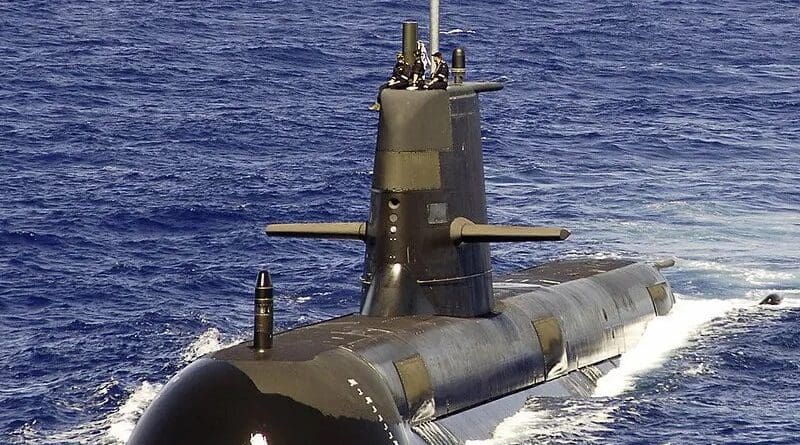Australia’s Submarine U-Turn – Analysis
By Richard Brabin-Smith*
On 15 September 2021, the Australian government formally announced that it was abandoning French Attack-class conventional submarines in favour of nuclear propulsion through AUKUS. There were two principal causes for the decision.
It was an open secret that negotiations between Australia and France had been difficult. It proved impossible to reconcile France’s largely commercial interest in the deal with Australia’s strategic imperative. Perhaps France, not being a nation of shopkeepers, overlooked the cardinal rule that the customer is always right — or at least should be listened to attentively.
The strategic arguments are less speculative and more compelling. Australia’s 2016 Defence White Paper was complacent, showing little recognition of how much the country’s strategic circumstances were deteriorating. In contrast, the 2020 Defence Strategic Update concluded that shortened warning times and growing Chinese belligerence represented significant strategic deterioration.
Australia has been reluctant to consider nuclear-powered attack submarines (SSNs) because of the cost and political effort required to make the nuclear case to the public. It is a mark of the seriousness of its strategic concerns that the Australian government is prepared to carry the arguments on both fronts. Allies might also have become more willing to share their highly sensitive nuclear technologies.
The capability arguments for SSNs — high speed, unlimited range, endurance set only by what the crew can tolerate, greater stealth and larger weapon loads — are well known. Their earlier disadvantage of being noisier than conventional boats has been largely overcome. These characteristics will help meet the operational challenge posed by the great distances between bases in Australia’s south and the archipelagic focal areas to its north.
Australia faces a choice between versions of the UK Astute-class and the US Virginia-class. Their submerged displacements are comparable: the Astute at 7400–7800 tonnes, and the Virginia at 7900 tonnes (Australia’s current Collins-class submarines are 3400 tonnes and the Attack-class would have been some 4900 tonnes). The new Block V Virginias will displace some 10,200 tonnes, enabling them to carry an additional 28 Tomahawk missiles. This could make them attractive to Australia, with its increased focus on long-range missiles for strike and deterrence.
While the United Kingdom will build seven Astutes, the United States has already ordered 34 Virginias with the prospect of a total of up to 50 or more, depending on the transition to the next class of US SSNs. Such a long production run offers good prospects of through-life support and improvements.
It will be critical for Australia to demonstrate high levels of nuclear safety to both the public and to regional countries. This will require a specialist and sustainable sovereign workforce in Australia’s Navy, Department of Defence and industry. The new AUKUS treaty needs to provide a framework for Australia to draw without inhibition on the decades-long expertise of the United States and the United Kingdom in nuclear engineering and the operation of SSNs.
Such a highly trained workforce would also help mitigate any loss of sovereignty that would come from an excess level of reliance on either country for nuclear expertise. Australia’s negotiations also need to guard against the return of US policies that would reduce its commitment to allies. At the same time, it needs to be recognised that shared and increasing concerns over Chinese assertiveness will bind Australia and its allies more closely.
Australia’s regional neighbours have their own worries about China, which will help them understand Australia’s position. If experience is to be a guide, they will tend to be more receptive to Australia’s diplomatic approaches in private than might appear in public pronouncements. Australia’s arguments should stress that China has brought this on itself — with less Chinese belligerence, Australia would not have responded in this way.
Australia’s SSN program will bring challenges of implementation. The country’s nuclear expertise is limited and negotiations could prove difficult. Still, this project is of such critical importance to Australia’s security that it will not be allowed to fail. Success will build on Australia’s strong capabilities in heavy engineering and complex project management, including — after some problems — the Collins-class submarines.
AUKUS is wider than just SSNs. For example, the US Navy’s plan to acquire up to 51 extra-large unmanned underwater vessels could benefit Australia’s exploration of this important option, not least as a mode for force expansion.
The United States and the United Kingdom are also builders of the world’s best SSNs (said to be much quieter than China’s) and Australia’s long-time security partners. Their commitment to helping will likely be generous — subject to the competing demands of their own submarine programs. Given the well-established intelligence relationships and navy-to-navy links, the habits of trust on which this endeavour will rely are already in place.
*About the author: Richard Brabin-Smith AO is Honorary Professor at the Strategic and Defence Studies Centre, The Australian National University. He was formerly deputy secretary for strategic policy and chief defence scientist at the Department Defence.
Source: This article was published by East Asia Forum

